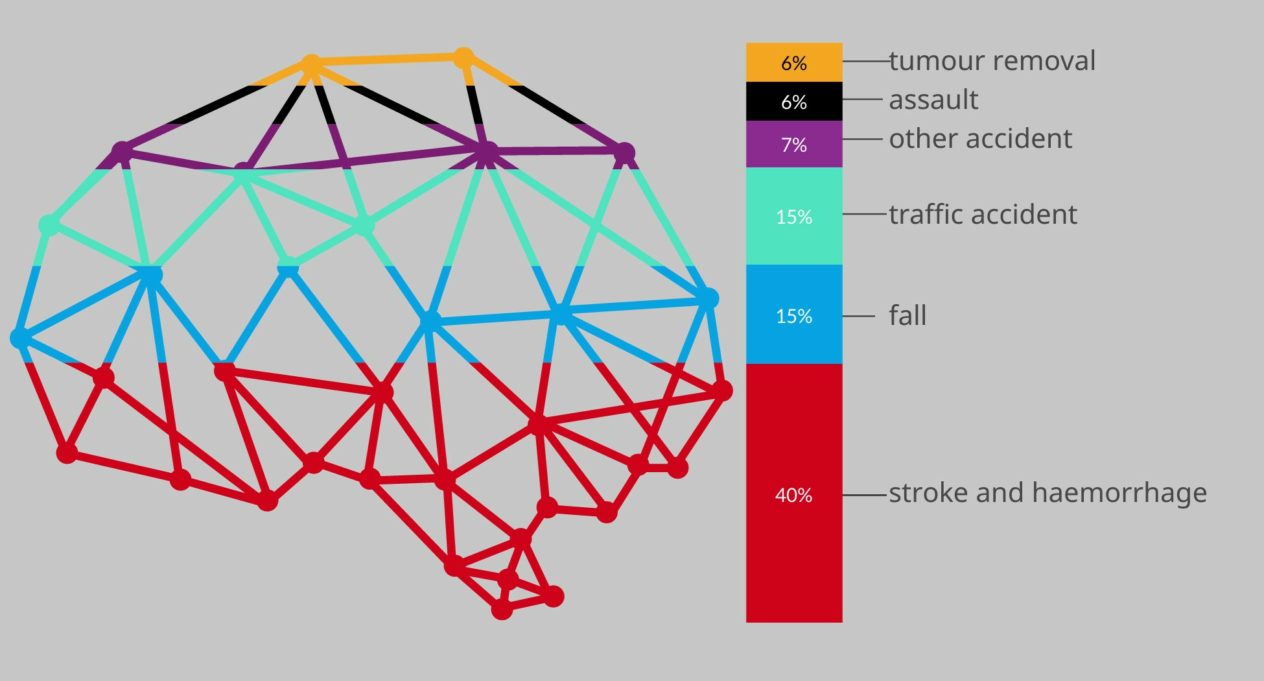An Acquired Brain Injury, sometimes referred to as ABI, is any injury to a person’s brain that happens during their lifetime. The injury can be caused by a stroke, a bleed in the brain, an infection, a tumour, a lack of oxygen or a fall, for example. This page has some basic facts about brain injury, see also the menu choices for more.
Every brain injury is different. Everyone has their own story.
ABI – Quick facts about brain injury
What causes Acquired Brain Injury?
A brain injury can occur as a result of:
- An impact to the head, such as in a traffic or workplace accident, a fall, an assault or a sports injury.
- A stroke, brain haemorrhage or brain surgery
- A viral infection occurring in the brain e.g. encephalitis
- Lack of oxygen to the brain (hypoxia)
The chart below illustrates the breakdown in the top 6 causes of brain injury for the clients who attend Headway services.
Top causes of Brain Injury

Who does it affect?
Brain Injury can happen to anyone at any time during their lives. It is the leading cause of death and disability especially in young people. Additionally, people aged between 15-29 years of age are three times more likely to get a brain injury than any other groups.
Irish statistics about brain injury
In Ireland currently, there are no reliable statistics about the numbers of people sustaining a brain injury each year or living with the consequences of injury. But we can base some estimates for how many people get a brain injury each year on the rates of incidence in other populations.
Typically, European incidence rates for Traumatic Brain Injury are in the region of 260 per 100,000 of population. If this was reflected in the Irish population, we would expect to see approximately 14,000 traumatic brain injuries a year. We also know that in Ireland, there are 7,500 strokes each year.
From these figures, we can estimate (conservatively) that there are at least 20,000 brain injuries happening each year.
Some estimates suggest that there are approximately 60,000 adults living with the consequences of stroke. Estimates based on studies elsewhere in Europe, suggest that approximately 0.7% of the population might be experiencing consequences of Traumatic Brain Injury, which would equate to nearly 40,000 people in the current population.
If we add those affected by traumatic brain injury, to those affected by stroke, we can estimate that there are likely to be over 100,000 adults affected by brain injury in Ireland.
That’s nearly 2% of the population.
Sources:
Epidemiology of Traumatic Brain Injury in Europe: A Living Systematic Review
Alexandra Brazinova et al.
Journal of Neurotrauma 2021 38:10, 1411-1440
Prevalence of Traumatic Brain Injury (TBI) disability: A national population-based survey
C. Jourdan, P. Azouvi, F. Genet, N. Selly, L. Josseran, A. Schnitzler,
Annals of Physical and Rehabilitation Medicine, Volume 58, Supplement 1,2015, Pages e148-e149
Epidemiology of traumatic brain injuries in Europe: a cross-sectional analysis.
Majdan, Marek et al.
The Lancet Public Health, Volume 1, Issue 2, e76 – e83
HSE National Stroke Strategy (National Stroke Strategy 2022-2027)
Irish Heart Foundation (Irish Heart Stroke – Irish Heart)
How does a brain injury affect people?
Many people with a brain injury make a good physical recovery. For some people what changes is the way they think and feel, how they talk to, get on with others, their memory, and how they experience the world. Some of these changes may only be obvious to close family and friends. This is why acquired brain injury is known as a ‘hidden disability’ and can bring the injured person and their family many hidden challenges. This means that brain injury doesn’t just happen to one person – it happens to a whole family.
What are the main types of Brain Injury?
| Strokes and Haemorrhages | A stroke happens when a blood vessel in, or around, the brain bursts or is blocked. This causes damage to the brain cells. A Haemorrhage is a bleed. – Read more |
| Traumatic Brain Injury | A Traumatic Brain Injury happens when an outside force is applied to the brain, or body, that affects the way the brain works. – Read more |
| Aneurysms and Arteriovenous Malformations | An Aneurysm is a weak spot on an artery that has bulged out. The walls of an aneurysm can burst because they are thin and weak from being stretched – Read More |
| Concussion | A Concussion is a blow to the head or body that causes the brain to shake inside the skull. This can change the way your brain normally works. – Read More |
| Infections | Infections of the brain or spinal cord can result in dangerous inflammation. This can affect the way the brain works. – Read More |
| Other kinds of brain injury | Lack of oxygen, brain tumours and encephalopathy are all possible causes of a brain injury. Find out more in this article – Read More |
What are the main effects of Brain Injury?
Common effects of Brain Injury
This page lists some of the common effects – Read More
Strategies for coping with changes
Living with changes caused by a Brain Injury
We have information to help you live with some common changes you might experience following ABI. See our downloadable booklets about brain injury – Read More